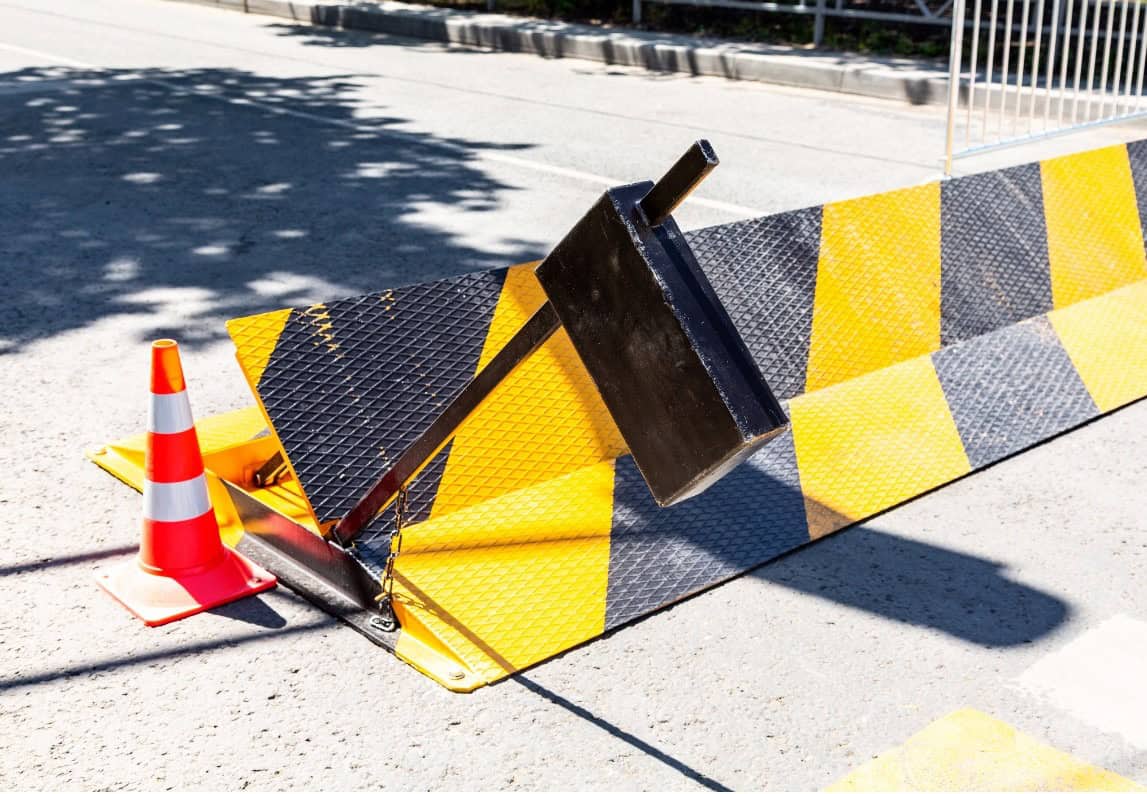Crash-rated wedge barriers are essential components in modern security architecture, designed to offer robust protection against vehicular threats in sensitive areas such as government buildings, military bases, and commercial complexes.
We’ll explore the various aspects of crash-rated wedge barriers, from their design and operational mechanics to their strategic implementation.
By understanding the crucial role these barriers play in security frameworks, organizations can effectively mitigate risks and ensure the safety of both assets and personnel. With a focus on technological integration and maintenance, this guide provides insights into selecting and utilizing the right crash-rated wedge barriers for your security needs.
Understanding Crash-Rated Wedge Barriers
Crash-rated wedge barriers are a crucial line of defense in high-security environments designed to halt unauthorized vehicles in their tracks. These barriers are engineered to withstand significant impacts, making them ideal for premises requiring stringent protection. Understanding the mechanics and capabilities of crash-rated wedge barriers is key for potential customers exploring robust security solutions. These systems are often installed at the perimeters of sensitive areas, where stopping an intruding vehicle before it can reach critical assets is paramount.
The effectiveness of crash-rated wedge barriers is largely determined by their design and construction materials. Made from high-strength steel and often reinforced with concrete or other resilient materials, these barriers are built to absorb and dissipate the energy of a high-speed collision.
This design ensures that vehicles do not breach the barrier, protecting property and lives. For organizations considering these barriers, evaluating the specific threat levels and choosing a barrier that meets the necessary security standards is important.
Operationally, crash-rated wedge barriers are quite versatile. They can be deployed rapidly in response to a threat, making them effective for permanent and temporary installations.
Some systems are designed for manual operation, while others are fully automated, allowing for remote activation in times of need. This flexibility ensures that barriers can be integrated seamlessly into existing security protocols, enhancing overall safety without causing undue disruption to daily operations.
For potential customers, investing in crash-rated wedge barriers involves careful consideration of their security posture and operational requirements. These barriers are an investment in safety and security, and selecting the right system involves assessing not only the initial installation cost but also long-term maintenance and operational efficiency. Engaging with experienced providers can help navigate these choices, ensuring that the selected barrier system optimally addresses the unique challenges of each secured site.
The Importance of Security Ratings and Standards
Understanding the significance of security ratings and standards is paramount for potential customers when evaluating security solutions like crash-rated wedge barriers.
These ratings, often determined by recognized certification bodies, ensure that each barrier meets specific impact resistance and durability criteria under real-world conditions. Adhering to these standards guarantees high protection and instills confidence in those relying on these security measures to safeguard their facilities.
Security standards for crash-rated wedge barriers involve rigorous testing to evaluate their performance against vehicle impacts. This includes assessments such as:
- Speed of Impact: The maximum speed a vehicle can travel at the time of collision without penetrating the barrier.
- Vehicle Type: The types of vehicles that the barrier can stop, which might range from passenger cars to heavier trucks.
- Penetration Rating: The maximum distance a vehicle might travel past the barrier after impact, typically measured in meters or feet.
Adopting barriers that meet or exceed these standards is crucial for organizations in sectors where security cannot be compromised. By choosing certified barriers, customers can be sure that the products have undergone exhaustive testing and can perform as expected under extreme circumstances. This peace of mind is invaluable, especially in environments with a high risk of vehicular attacks.
Compliance with these standards enhances a facility’s security and aligns with regulatory requirements that might be in place for certain industries. For businesses, this means protecting their physical assets and ensuring that they meet legal obligations for security measures. Engaging with suppliers prioritizing certified crash-rated wedge barriers can aid in navigating these complexities, ensuring that all security installations are effective and compliant.
Installation Guidelines for Wedge Barriers
Installing crash-rated wedge barriers is a critical process that requires meticulous planning and precise execution to ensure their effective operation and integration into existing security systems. Understanding the installation guidelines is key to achieving optimal functionality and security for potential customers. The first step in the installation process involves site assessment, where the specific location and environmental factors are evaluated to determine the most effective placement for the barriers.
The foundation for crash-rated wedge barriers must be robust and crucial to the barrier’s overall effectiveness. This often involves significant structural modifications to ensure that the barriers can withstand the impact for which they are rated. Professionals must oversee the construction of foundations that are deep and strong enough to anchor the barriers and positioned to provide maximum security without impeding authorized traffic flow.
Electrical and hydraulic systems are integral to crash-rated wedge barriers, particularly for automated models. These systems must be installed with precision to ensure reliable operation. The barriers to power sources and control systems should be connected in compliance with local safety standards. It’s essential to ensure that certified technicians perform these installations to avoid operational failures or safety issues.
Post-installation testing is critical to ensure the crash-rated wedge barriers function as expected. This includes both mechanical tests and live drills to simulate actual intrusion attempts. Regular maintenance checks are also recommended to keep the barriers in optimal condition. By adhering to these guidelines, customers can maximize the effectiveness and longevity of their security investments, ensuring that their facilities are protected against vehicular threats.
Maintenance Best Practices for Longevity and Reliability
Maintaining crash-rated wedge barriers is essential for ensuring they function effectively and have a long operational life. Regular maintenance checks are crucial as they help identify potential issues before they lead to system failures. Understanding that these barriers require routine and preventative maintenance can help potential customers plan for ongoing operational costs while ensuring the barriers remain reliable under all circumstances.
One key aspect of maintaining crash-rated wedge barriers is the regular inspection of mechanical components. These inspections should focus on the integrity of the barrier, hydraulic systems, and electrical components to ensure everything operates. Any signs of wear and tear, such as hydraulic fluid leaks or rusting parts, should be addressed immediately to prevent malfunctions during critical times.
Potential customers should also ensure that trained professionals maintain these barriers. These experts have the knowledge and tools to perform complex checks and repairs. They can also update any system software to enhance barrier functionality and ensure compatibility with the latest security technologies.
Implementing a scheduled maintenance plan is advisable to extend the life of crash-rated wedge barriers. This plan should include regular cleaning, testing, and calibration of the barriers tailored to the specific environmental conditions and frequency of use. Such proactive maintenance enhances reliability and maximizes the investment by prolonging the equipment, ensuring that the barriers continue to offer the highest level of security.
Products to Include in Your Crash-Rated Wedge Barrier System
When it comes to ensuring the security and protection of sensitive facilities, crash-rated wedge barriers are essential components. These barriers are specifically designed to halt unauthorized vehicle access, providing a robust defense against potential threats. Below, we outline some of the top products in the market that are ideal for creating a reliable and effective crash-rated wedge barrier system.
HySecurity: StrongArm M30/M50
A high-security barrier arm designed for maximum protection and durability. Ideal for critical infrastructure and high-threat environments, ensuring robust access control.
Key Features
- Rated for high-security applications
- Robust and durable construction
- Ideal for critical infrastructure
- Enhanced access control features
- Designed for high-threat environments
FAAC: B680H
A high-performance barrier known for its reliability and speed. Suitable for heavy-duty applications, it offers seamless operation with advanced safety features.
Key Features
- High-speed operation
- Reliable performance for heavy-duty applications
- Advanced safety features
- Seamless and efficient operation
- Long-lasting and durable
Liftmaster: MATIBAR
An automatic barrier gate that combines efficiency with ease of use. Perfect for controlling vehicular access in commercial and residential areas, providing dependable security and convenience.
Key Features
- Efficient automatic operation
- Easy to use and install
- Suitable for commercial and residential areas
- Dependable security features
- Enhances vehicular access control
Integrating Technology for Enhanced Security Measures
These barriers become more than static security elements by incorporating technologies such as motion sensors, automatic activation systems, and surveillance cameras. They transform into dynamic parts of a comprehensive security system that can detect threats and respond appropriately in real-time, providing higher protection and control.
Automated systems allow for the remote operation of crash-rated wedge barriers, which can be raised or lowered without manual intervention. This capability is particularly valuable in scenarios where immediate response is crucial. Integration with broader security networks also means that barriers can be synchronized with other security measures, such as alarms and lighting systems, to enhance a facility’s overall security posture.
Choosing the Right System
When selecting a crash-rated wedge barrier system, consider the specific needs of your site, including the level of threat, installation environment, and required response times. Each of the products listed offers unique features that cater to different security requirements.
For more information on these products and to discuss the best options for your specific needs, contact R3 Access at 215-364-5868 or visit our website at r3accessinc.com. Our experts can provide personalized recommendations and support to ensure your facility is protected with the highest standards of security.


